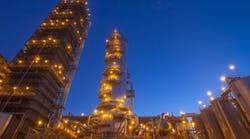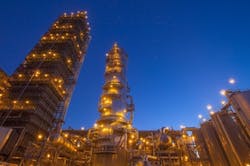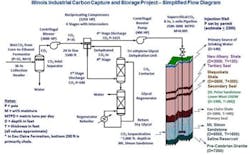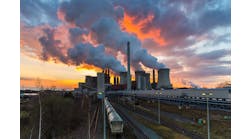The implications of the U.S. government’s decision to pull out of the Paris
Climate Accord stir heated debate. Regardless, many American chemical companies — driven by shareholder demands, concerns over public image and, sometimes, pure economics — likely will continue to pay significant attention to greenhouse gas emissions. (See: “Look Beyond the Paris Accord Pullout.”) In addition, the worldwide focus on developing carbon dioxide capture and storage (CCS) technologies remains strong.
According to the Global CCS Institute, Melbourne, Australia, 40 large-scale CCS facilities are in various stages of development, including 17 already in operation. In fact, notes the institute, over 200 million metric tons of CO2 have been injected securely into the sub-surface since the early 1970s — a powerful counter to those arguing the technology is experimental or untried, it contends.
Tellingly, two of the major CCS projects to come onstream in 2017 are based in the U.S.
Major Step
In January, Petra Nova, a joint venture between NRG Energy, Houston, and JX Nippon Oil & Gas Exploration, Tokyo, started CO2-capture operations at the W.A. Parish power plant near Houston. The project can capture more than 5,000 t/d of CO2, which then is used to boost production at the West Ranch oilfield that is jointly owned by NRG, JX Nippon and Hilcorp, Houston. Petra Nova estimates oil production in the field will rise over the next few years from 300 bbl/d to 15,000 bbl/d once CO2-driven enhanced oil recovery gathers pace.
Figure 1. Texas project relies on a patented amine solvent and special proprietary equipment. Source: MHI.
Key to the whole project is the Kansai Mitsubishi CO2-recovery process developed by Mitsubishi Heavy Industries (MHI), Tokyo. This includes patented KS-1 amine solvent and special proprietary equipment (Figure 1).
“KS-1 is a sterically hindered amine, while the most common amine used for carbon dioxide capture, monoethanolamine, is a primary amine. KS-1 provides higher absorption capacity, lower energy requirement and more oxidation and corrosion resistance as compared to conventional amines. Less amine makeup and steam consumption are required,” says an MHI spokesman.
The Petra Nova plant also features proprietary equipment and process innovations developed by MHI, he adds. For example, adaptations made to reduce solvent oxidation and amine emissions from the absorber effectively decrease amine loss. In addition, an energy-saving process around the regenerator cuts steam consumption.
The process itself underwent small-scale pilot plant testing at MHI’s R&D center in Hiroshima, Japan, before being scaled up at a larger pilot plant in Osaka.
A major stepping stone from this to the Petra Nova application came in 2011 with a project at Alabama Power’s Plant Barry, Bucks, Ala. The world’s first fully integrated coal power and geological storage project, it captures over 500 t/d of CO2 .
“All the MHI technologies applied to Petra Nova plant were successfully demonstrated at the Plant Barry, showing high operability and high efficiency of CO2 capture while minimizing energy consumption,” notes the spokesman.
The flue gas at the Alabama plant was challenging because it contained SOx, NOx and particulates that typically exacerbate amine losses and degrade CO2 capture efficiency, he explains.
“The countermeasures developed by MHI significantly reduced the impact caused by such impurities contained in dirty flue gas. As a result, MHI applied the experiences and lessons learned from the Plant Barry project and successfully scaled up by ten times at Petra Nova.”
Meanwhile, April saw the launch of the world’s first large-scale bio-energy with CCS project. The facility in Chicago can capture and store approximately 1 million t/y of CO2; it is operated by bio-ethanol producer Archer Daniels Midland (ADM), Chicago, and administered by the U.S. Department of Energy’s (DOE) Office of Fossil Energy. Known as the Illinois Industrial CCS (ICCS) project, it’s also the first U.S. CCS facility to store substantial quantities of CO2 in a geological formation (Figure 2). ICCS project partners handled the design, construction, demonstration and integrated operation of all the CCS processes involved.
Norwegian Initiative
Also this year, Aker Solutions, Fornebu, Norway, won contracts for conceptual studies for carbon capture at an ammonia plant in Porsgrunn, Norway, of Yara International, Oslo, and a cement production facility in Brevik, Norway, of Norcem, Oslo.
Yara and Norcem are among three companies in the running to receive Norwegian government funding to build and operate a full-scale carbon capture plant. The government aims to fund at least one of the plants, which would be operational by 2022, as part of an overall NOK 1.3-billion ($156-million) investment in CCS technologies.
The Yara study will involve designing and developing a capture plant for the reformer flue gas and also will include liquefaction. The study for Norcem will focus on designing a carbon capture plant that’s integrated with the cement factory, including a process to turn the CO2 into liquid, together with storage facilities that can be used before shipping; the plant will have a capacity of about 400,000 t/y of CO2. Both conceptual studies should be completed in September.
Aker’s proprietary ACC carbon capture process uses a mixture of water and organic amine solvents to absorb the CO2. The company says its process gives high capture rates with low energy consumption while the solvent is robust and requires minimum makeup.
Figure 2. New facility in Illinois is the first in the U.S. to store substantial quantities of CO2 in a geological formation. Source: ADM.
Following the conceptual studies, efforts will turn to front-end engineering design until around mid-2018. The Norwegian government expects to make an investment decision in the first half of 2019.
Much of Aker’s experience with the design, construction and operation of amine plants has come at the Technology Centre Mongstad (TCM), Mongstad, Norway, together with extensive tests in the U.S., the U.K. and Norway using its mobile carbon capture plant.
TCM, which plays a key role in the Norwegian government’s CCS efforts, has received a boost with the announcement that Norway’s Gassnova, Porsgrunn, and Statoil, Stavanger, as well as Shell, The Hague, The Netherlands, are continuing their participation in test operations there until 2020. Total, Paris, now is joining this work, too.
“Test operations on TCM have played a very important role in uncovering areas for technology improvements that have helped to drive the cost of CCS down, and we see that such learning takes place in every test campaign. We believe that this will also be the case in the coming years and this is therefore an important contribution to achieving the objectives of Shell’s strategy in the CCS,” says Tor Arnesen, Norske Shell CEO.
“This is a strategic investment for Total and in keeping with our commitment to combat climate change in two ways: by enhancing our expertise in CCUS [carbon capture, utilization and storage] technologies, and reducing carbon emissions from our production plants. Therefore, we believe it is important to be involved in this project, which is the only industrial-scale one in Europe,” adds Philippe Baptiste, Total CTO.
British Project
Meanwhile in May, CCS technology development in the U.K. took a step forward with the announcement that the Acorn project in northeast Scotland has won support in the latest funding round for the European Union’s “Advancing CCS Technologies” initiative.
The funding will enable a small-scale project from which a more-extensive CCS network could evolve. The project itself will capture CO2 emissions from the St. Fergus gas processing plant and transport them for permanent storage deep beneath the North Sea in existing redundant oil and gas infrastructure that currently is under threat of decommissioning. The plan is for St. Fergus to serve as a future hub for CCS, getting gas from central Scotland via multiple pipelines as well as imports shipped in to nearby Peterhead harbor. Already £100 million ($129 million) of public money has been spent on an evaluation of the strategy being pursued.
“There were two parallel trains of gas processing there for 25 years and an existing amine plant. The plan is to re-use infrastructure like this. The CO2 will be dried, compressed and then sent to the storage sites,” explains Sam Gomersall, commercial director at Pale Blue Dot Energy, Banchory, Scotland, a management consultancy with over a decade’s experience with CCS projects.
One of these involves a prospective CCS operation in Teesside, northeast England, a heartland of U.K. chemical production. There, the Teesside Collective, a consortium including companies in energy-intensive industries, aims to create the U.K.’s first CCS-equipped industrial zone.
The project targets emissions from collective member, Lotte Chemical, Wilton, which makes PET resin. Its site produces about 55,000 metric tons of CO2 annually; a CCS plant would capture 90% of that.
“We delivered a project on a capture plant on the Lotte site and we are now into a more detailed design and costing phase. The company is very enthusiastic about moving it forward. The challenge now is getting funding for the next stage,” notes Gomersall.
Emerging Developments
Other parties are moving to commercialize novel technologies they believe will play an important role in future CCS strategies.
One of these is Air Products, Allentown, Pa., which is working closely with the Norwegian University of Science and Technology (NTNU), Trondheim, to commercialize the latter’s fixed site carrier (FSC) membrane technology. This allows highly energy efficient capture of CO2 from flue gases and biogases. The two signed an exclusive license agreement in February.
The NTNU technology uses a process called facilitated transport to remove the CO2 from other gases. Instead of a filter effecting the separation, an agent acting as fixed carrier within the membrane helps to convert the CO2 — in combination with moisture — into bicarbonate that is quickly transported through the membrane.
Air Products and NTNU researchers already have achieved good results in tests in industrial plants. They also found the technology can serve to upgrade biogas to methane.
A spokeswoman for Air Products adds that previous testing was mainly lab-scale and the focus now is on scaling up to a commercial product.
At the research level, every aspect of CCS technology is receiving close scrutiny. For example, scientists at King Abdullah University of Science and Technology (KAUST), Thuwal, Saudi Arabia, are focused on developing new materials that can capture CO2 at very low concentrations.
A team led by professor Mohamed Eddaoudi, associate director of the university’s Advanced Membranes and Porous Materials Research Center, points to a breakthrough in metal organic frameworks (MOFs). Its latest MOF can take up CO2 even when present at concentrations as low as 400 ppm.
The key to the new MOF’s performance is its structure: square-grid layers encompassing Ni(II) metal centers and pyrazine linkers, bridged via pillars composed of niobium, oxygen and fluorine atoms.
“The ability to control the distance between the fluorine atoms allowed us to create the ideal square-shaped pockets for trapping CO2 molecules effectively and efficiently and giving our material such impressive performance,” explains Eddaoudi.
He believes the MOF might suit a wide range of static industrial applications that produce CO2, including direct capture from air.
The team now is working to scale up the use of its new MOF and looking for industry collaboration as the next step towards commercialization.
Meanwhile, researchers at the University of Amsterdam (UvA), Amsterdam, the Netherlands, have stumbled upon a catalyst that could make the conversion of CO2 into useful chemicals a commercial proposition.
Working within UvA’s sustainable chemistry research priority area, chemists Edwin Gnanakumar and Shiju Raveendran have invented an enzyme that can efficiently convert CO2 into CO under relatively mild conditions.
“It was an accidental discovery,” admits Raveendran. “We were experimenting for a different product but the catalyst turned out to be highly selective for CO2, better than any reported ones.”
Longer-term tests in a flow reactor confirmed the catalyst remains active — pointing up its promise for scaleup for applications such as industrial flue gas conversion. The technology is readily adaptable to handle large amounts of gases, according to the researchers.
The new catalyst is easily prepared and inexpensive, and converts CO2 at ambient pressure and low temperatures, Raveendran adds.
The researchers now are in the process of commercializing the catalyst with help from UvA’s in-house technology transfer office.




